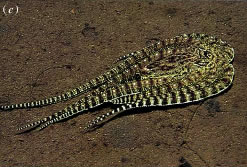Visual Mimicry in Cephalopods
Biology 342 Fall 2007
Aurelia Moran & Matt Lehet
Imitation is the sincerest form of flattery
-Charles Caleb Colton
Many cephalopods use their ability to change color, reproduce patterns, and contort their bodies to mimic other species. For example, Sepioteuthis sepioide, a species of squid, has been observed imitating a parrot fish. In order to do so, it swims in reverse and produces a display of two eye spots. It holds its tentacles and arms together and undulates from side to side imitating a fish’s fin. The parrot fish is herbivorous, and mimicking them allows the squid to get closer to potential prey species that do not consider parrot fish to be their predators (Hanlon & Messenger, 1996).
Sepioteuthis sepioidea, the Caribbean reef squid, orients itself perpendicular to the predator and stretches out its mantle and fins in order to appear larger. This is an example of defensive mimicry. Image taken by James Wood with a Nikonos V during the 2001 study of communication in reef squid in Bonaire. This project is led by Dr. Jennifer Mather and has been ongoing since 1998.
The most recently published example of mimicry is that of Thaumoctopus mimicus. It lives in sand substrates near the mouth of rivers in Indonesia, and was only discovered in 1998. Specimens have been observed to mimic the shape of multiple venomous animals which cohabitat its ecological niche. This is the first case of a cephalopod which appears to impersonate other species as a defense mechanism in order to deceive its predators. The mimic octopus, has been documented undulating its body like flatfishes, mimicking the shape and movement of the lion-fish and in an extreme case of contortion, the octopus mimics the poisonous banded sea-snake. In order to do this, the octopus must bury all but two of its arms in the sand, while it two remaing arms are pointed in opposite directions with striped markings which it moves in an wave-like pattern (see video below) (Norman et al, 2001). Still other cephalopods such as Octopus marginatus and Octopus aculeatus use camouflage to deceive predators.
http://www.journals.royalsoc.ac.uk/content/pp95mdq58uyhe4ru/media4.mov


Thaumoctopus mimicus displaying their ability to contort their bodies in order to mimic a flatfish, on the left, and a lionfish, on the right. Photographs taken by M.Norman and R. Steene.
Video of mimicus mimicking a flatfish:
http://www.journals.royalsoc.ac.uk/content/pp95mdq58uyhe4ru/media2.mov
Mimicry describes a situation where one organism, the mimic, shares common phenotypes with another organism, the model. The evolution of mimicry occurs through the selective action of a signal-receiver. The model is usually another species, or less commonly, the mimic's own species. The signal-receiver is typically another intermediate organism such as, the common predator of two species. Mimicry is generally advantageous to the mimic and harmful to the receiver, but may increase, decrease or have no effect on the fitness of the model. Models are often hard to define, as the organism which is being mimicked may be difficult to pinpoint. For example, the mimicry of eye spots, which may not be easily traced back to the species of origin, can have variable effect on the model species' fitness.
Camouflage, in which an organism appears similar to its surroundings, is a form of visual mimicry. As a form of mimicry it is confined to cases in which the model is abiotic. The lack of true distinction between the two phenomena (mimicry and camouflage) can be seen in animals that resemble parts of plants. They are classified as camouflaged (a plant is a part of an organism's environment) and as mimics (a plant is also an organism). Camouflage in Cephalopods takes one of three forms, either a direct imitation of the surrounding environment, a disruptive coloration designed to break up the edges of the animals profile by mimicking the visual noise around it, and a hydrostatic musculature contortion to mimic other animals.(Barbosa, 2007).
Defensive mimicry occurs when organisms avoid an encounter that would be dangerous by deceiving another organism. Through their deception they are treated in a more favorable fashion. In Batesian mimicry the mimic uses signals which are similar to the model, but does not have the attribute that makes it unprofitable to predators. Mimics of this sort are less likely to be found out when in low proportion to their model, a phenomenon known as negative frequency dependent selection which applies in most other forms of mimicry as well. In Müllerian mimicry the mimic uses signals which are similar to the model, but does have the attribute that makes it unprofitable to the predators. Thus the effective population size of the organism is increased. The mimicking and mimicked organisms may be undifferentiable by a common predator, and thus the threat posed by that predator is reduced for each individual through this form of mimicry.
"the creeping murderer, the octopus... pretending now to be a bit of weed, now a rock... runs lightly on the tips of its arms."
John Steinbeck